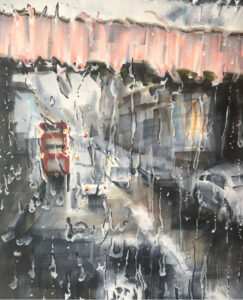the toughest season yet
Aspiring mall Santas might want to work on their ho-ho-hos this year. The red suits may still sparkle under the fluorescent lights of shopping centers, but the mood among job seekers feels colder than a December wind. The 2025 holiday job market, once a dependable cushion for the unemployed or underemployed, has tightened into something leaner, more ruthless, and less sentimental. What was once a time of opportunity and community has turned into a contest of persistence and timing.
The numbers tell a story that’s hard to spin with tinsel. According to Indeed, searches for seasonal jobs are up twenty-seven percent compared to last year and fifty percent higher than in 2023. Yet actual openings have grown just 2.7 percent from 2024 — a sliver of what would once be normal expansion for the retail rush. That imbalance means competition for cashier counters, stockrooms, and delivery shifts is fiercer than ever.
Economists have their explanations, each wrapped in its own cautious phrasing. The simplest one is that hiring overall has cooled. The U.S. economy, while not in crisis, is slowing. ADP’s payroll data showed a loss of 32,000 private-sector jobs in September, an unwelcome figure that quietly rippled across the labor market. Many workers who would have spent the season shopping are instead looking for work — and they’re doing it earlier. Applications for holiday positions have been landing since late August, long before the usual crunch, a collective recognition that waiting until November might mean being left out in the cold.
the disappearing comfort of the seasonal job
The changing rhythm of the labor year has its own symbolism. Holiday work was once a given: teenagers earning pocket money, retirees looking for structure, parents juggling part-time schedules. Today, it feels less like tradition and more like survival. There are more hands reaching for fewer ribbons.
That scarcity has precedent. The outplacement firm Challenger, Gray & Christmas — a kind of long-view historian of hiring trends — forecasts that retail holiday hiring could fall eight percent from last year, marking the lowest point since 2009. Back then, the Great Recession gutted consumer confidence and made the shopping season a grim ritual of austerity. The comparison isn’t perfect, but the echo is eerie. Once again, Americans are hesitant to spend, and companies are reluctant to gamble.
Behind this restraint lies a trifecta of modern anxieties: tariffs, inflation, and technology. Tariffs have raised the cost of imported goods, squeezing retail margins. Inflation, though tamed from its post-pandemic highs, continues to backdrop wage growth, leaving employers cautious about adding payroll costs. And automation — that silent, efficient, inexorable force — has crept deeper into every corner of commerce.
automation’s quiet takeover
Walk through a big-box store today and notice how few registers have human attendants. Warehouses that used to thrum with the noise of seasonal hires now hum to the rhythm of conveyor belts and AI-guided scanners. Even the call centers that once overflowed with temporary staff are increasingly populated by synthetic voices, handling customer questions faster, cheaper, and without overtime pay.
It’s not that companies have abandoned the human touch entirely. Amazon, ever the seasonal giant, will hire a quarter-million workers for the holidays — the same as last year. Yet the very consistency of that number underscores the stagnation. Growth has plateaued. Target, meanwhile, has made it clear it plans to rely largely on existing employees, offering them more flexible hours instead of expanding headcount. UPS and FedEx, perennial barometers of the shipping boom, have yet to declare their holiday hiring goals. Their silence has been taken as an omen: automation and strategic efficiency may do the heavy lifting this year.
In the aggregate, the picture is unmistakable. The era of exuberant seasonal hiring, when corporate press releases announced record recruitment drives and managers scrambled to train armies of temporary elves, has faded into something smaller, meaner, and more mechanical.
cautious spending, colder moods
That contraction reflects not just economics but sentiment. The National Retail Federation expects the average shopper to spend 1.3 percent less this year — hardly a collapse, but a signal of restraint that retailers can’t ignore. The psychology of the season has shifted. For all the talk of pent-up demand and “revenge shopping,” consumers are tired: tired of high prices, tired of uncertainty, tired of the feeling that the next month could bring either a windfall or another recession headline.
And when shoppers scale back, employers follow suit. The feedback loop is simple and brutal: fewer sales mean shorter shifts; shorter shifts mean fewer hires; fewer hires mean slower service, which can further dampen enthusiasm. The holidays, that grand annual experiment in optimism, depend on momentum — and this year, the sleigh is gliding uphill.
the fading glow of retail tradition
Perhaps the most profound change isn’t statistical at all. It’s cultural. Seasonal work has always carried a faint glow of mythos. There’s a sentimental familiarity in donning the red apron or the Santa beard, in becoming part of the temporary workforce that powers the nation’s collective ritual of giving. For many, it was a social anchor — a way to connect, to participate, to feel useful in a time that celebrates generosity.
But as automation expands and online shopping dominates, that sense of shared purpose thins out. The mall Santa, once the ambassador of retail joy, now competes not only with other applicants but with dwindling demand. Fewer malls host the elaborate holiday setups of old; more rely on digital photo booths or pop-up experiences. Even nostalgia has a price ceiling.
Agencies that supply Santas and holiday performers report rising interest but fewer bookings. The paradox feels almost Dickensian: plenty of Santas, not enough chimneys. Those who do land roles describe an odd dissonance — more crowds taking pictures, fewer parents buying toys on site. The job remains joyful, but the context feels transactional.
If Santa is the symbol of the season, he’s also become a mirror for the broader labor story: still smiling, still present, but stretched thinner than ever.
adaptation in the age of precarity
For workers, the tightening market demands agility. Those who once counted on retail shifts are drifting into logistics, delivery, and e-commerce support — sectors that, while steadier, often lack the warmth of face-to-face service. The job may pay, but it rarely sings. Yet necessity breeds adaptation. Workers are learning new rhythms: how to manage app-based scheduling, how to navigate warehouses instead of showrooms, how to wrap gifts they’ll never see delivered.
Economists call this flexibility. Workers might call it endurance.
Still, the numbers hide something human. Behind every data point — every percentage drop or cautious projection — is a person looking to make rent, buy presents, or simply feel useful. For them, the holiday season isn’t an economic cycle; it’s a lifeline. And when that lifeline frays, the consequences ripple outward, quietly reshaping the emotional landscape of the holidays.
the lonely hum of efficiency
A season defined by generosity feels stranger when its labor backbone tightens. There are fewer spontaneous smiles behind counters, fewer stories swapped during closing shifts, fewer people earning the small comforts that make December bearable. What replaces them are efficiency metrics, delivery quotas, and self-checkout screens. Progress, yes — but a lonely kind.
Still, even in the frost, small lights endure. Independent stores and local markets, less bound by corporate austerity, continue to hire with a touch of optimism. Some see opportunity in the vacuum — the chance to capture customers seeking authenticity, to make the shopping experience human again. These pockets of resistance remind us that retail, at its best, is an act of community, not just commerce.
And there are workers who, despite the odds, still find meaning in the temporary. For them, the holiday job is not just a paycheck but a rhythm of belonging — a return, however brief, to the hum of collective effort. The season may be leaner, but the spirit hasn’t vanished entirely; it has simply adapted, wearing new uniforms in new kinds of workplaces.
the uncertain road to 2026
Looking forward, the path remains uncertain. Economists suggest that if inflation cools further and tariffs stabilize, 2026 might see a modest rebound in hiring. But the structural shifts — the automation, the lean staffing, the preference for flexibility over expansion — will not reverse easily. The holiday workforce of the future will likely be smaller, more specialized, and increasingly mediated by technology. The cheer will still exist, but it will come through different channels — perhaps through the quiet efficiency of a warehouse worker scanning your package at midnight, rather than a sales clerk wrapping it with ribbon at noon.
In that transformation lies a story bigger than the holiday rush itself. It’s about how work, identity, and festivity intertwine — how the rituals of labor give shape to the rituals of celebration. When one shifts, the other inevitably follows. The decline of seasonal hiring isn’t just a business headline; it’s a cultural pulse check. It tells us how Americans feel about money, security, and togetherness at the year’s end.
warmth in a colder economy
Every December, we decorate our uncertainty with lights and carols, convincing ourselves that goodwill can outshine the market’s shows. Maybe it can. But this year, the contrast feels sharper. Behind the glow of storefronts and the efficiency of one-click deliveries lies a quieter truth: that joy, like labor, is still a human enterprise — fragile, finite, and worth protecting.
So when those mall Santas take their seats this year, their smiles might carry an extra layer of meaning. They’re performing nostalgia in a world that’s rapidly automating it. They’re holding space for something the algorithms haven’t yet learned to reproduce — the spontaneous warmth of shared time. And in a labor market colder than the North Pole, that warmth might be the rarest job benefit of all.
No comments yet.








